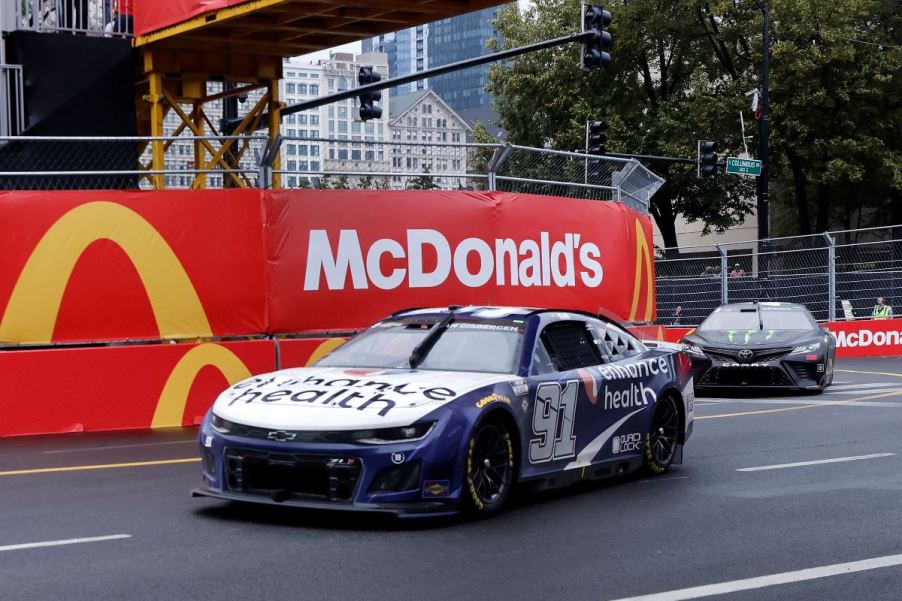
The Biggest Differences Between NASCAR Cup Cars and Australian V8 Supercars
Two weeks ago, V8 Supercars driver Shane van Gisbergen shocked the NASCAR world by winning in his first-ever race on the streets of Chicago. While many were surprised by SVG’s instant success, understanding more about how Australian Supercars match NASCAR Cup cars may inform that instant compatibility. Still, the cars aren’t completely identical, and we’re here to highlight a few technical differences that separate how these two cars drive.
The tires are vastly different between a Supercar and NASCAR Cup car

Whether it’s a race car or a road car, tires are the number one way to affect the handling characteristics of a vehicle. And when comparing an Australian Supercar to a NASCAR Cup Car, tires are one of the biggest differences.
In NASCAR, the Cup Cars use an 18 x 14 BBS wheel with Goodyear tires. The radial tires are wide at 365 millimeters, with a 35-ratio sidewall. That’s a pretty low sidewall for a race car, and many drivers report that the grip falloff is instant. In other words, when the tire starts to lose traction, it does so all at once, making a slide nearly impossible to catch.
In Australian Supercars, the cars use a 280 mm tire with a 40 ratio sidewall on 18-inch wheels. The narrower tire means it’s harder to get the power down, but the added sidewall allows for a more forgiving tire slip through the corners.
This means that, even mounted on similar machinery, the tires alone make for a much different driving experience between the Australian Supercars and NASCAR Cup car.
How heavy is a NASCAR race car?

NASCAR’s NextGen car is in its second year, and the Supercar-inspired design is lighter than previous generations. Still, for a race car, the Cup Series car is heavy at 3,200 pounds without the driver and fuel. Meanwhile, an Australian V8 Supercar weighs 1335 kg, or just over 2,900 pounds, making it significantly lighter.
The lesser weight does make the Australian Supercar more agile, but when paired with the narrower tire the two cars aren’t separated by much when it comes to cornering capability. The biggest difference is in the driver’s feel, where managing the extra weight means understanding just how hard to push before the tires lose their grip of the road.
Aerodynamic differences make managing traffic vastly different
Perhaps the most noticeable difference when comparing the NASCAR Cup Series car and the Australian Supercar is in the wings. NASCAR’s contender uses a small rear lip spoiler and stepped front splitter with an underwing and rear diffuser. As such, most of the aerodynamic downforce comes from beneath the car.
That has a big bearing on suspension settings. NASCAR crews are aiming to get their cars as low to the ground as possible to enhance aerodynamics. That means stiff suspension setups that can’t handle bumps and curbs. Plus the inherent risk of damaging the underwing if drivers hit a curb too hard.
In Supercars, however, the big rear wing provides a majority of the downforce. That allows those crews to run higher, softer settings. In turn, drivers can be much more aggressive over curbs, and the car itself can better maintain grip since the shocks, springs, and roll bars don’t have to be so rigid.
In addition, the Australian Supercars are much better at following each other closely, as you’ll see in the video below. Because the big wing is up off the back of the trunk, it can catch air even when the car is in traffic. NASCAR has a notable issue with this, as the disturbed air causes following cars to lose their grip.
Two approaches to the same style of racing
Whether you’re a fan of NASCAR or Australian Supercars, they’re two versions of the same type of racing. Full-bodied stock cars with aggressive drivers and on-the-edge handling make both series exciting to watch. And while there are certainly some big technical differences, the two cars are similar enough that crossover efforts allow drivers to have success across disciplines.




